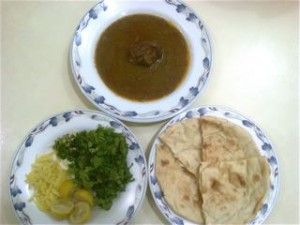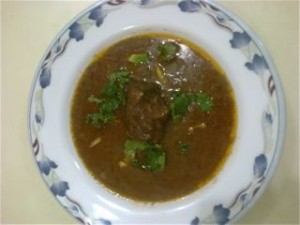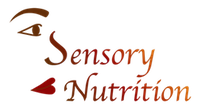
Pakistani cuisine which will dazzle your senses is being featured in this next two-part blog series during March 2014. This Part 1 includes details about a number of the wonderful nuances of some of the better known cultural dishes and spices that help to bring out the distinctive flavors of Pakistani cuisine. Part 2 focuses on a glimpse of a typical Pakistani cultural dietary pattern.
Earlier this month, we introduced our Guest Author for 2014 National Nutrition Month (NNM), Pakistani Registered Dietitian, Teba Abdul Lateef, who recently accepted a college lecturer position in Karachi.
Teba is helping us to globally celebrate the 2014 NNM theme (education and information campaign slogan) “Enjoy the Taste of Eating Right.” {Please note that the term “taste” is being used broadly here in the NNM theme to refer to more than just the sense of taste, but also to refer to the larger concept of flavor.}
Any NNM celebration has typically showcased Registered Dietitians (RDs) / Registered Dietitian Nutritionists (RDNs) in the United States of America (USA) encouraging consumers to think more about the food choices they make and the impact those can have on health, not just during NNM, but everyday. NNM is sponsored by the Academy of Nutrition and Dietetics in the USA, which also offers food and nutrition focus public service announcements via EatRight Radio.
We wanted to go global in celebrating NNM this year, since the Academy is encouraging consumers to explore some tasty food choices which may be new to them, as well as “experiment with new flavors and new flavor combinations” when seeking to put together tasty, nutritious meals to support health.
After Teba, a dietetic and nutrition colleague, reached out to us from across the globe in Pakistan, we decided to collaborate to share some of Teba’s excitement when it comes to food and nutrition. You can read more about Teba in the first series of articles for NNM focusing on Tasty Food Can Be Both Delicious and Nutritious, including some of her tips in Part 1 and a couple of her original recipes in Part 2.
Just like Stephanie, Teba encourages consumption of real, whole food whenever possible. Registered Dietitians in Pakistan are gradually helping the public there to explore ways to reduce added oil and other added fat content of many traditional recipes which have had higher total fat content. They are also promoting greater plant food intake. Just as such positive dietary change continues to take time in the USA, it is also taking time in Pakistan.
When asked to write about Pakistani cuisine, Teba responded by providing some details in English for Stephanie to work with, even though Urdu is Teba’s native language. Below is the first part of their collaborative effort in which Teba shares some particulars of her native Pakistani cuisine. Part 2 will feature details of a typical Pakistani cultural dietary pattern. We hope you enjoy both blog entries!
The Dazzling World Niche of Pakistani Cuisine
Draft by Teba Abdul Lateef; Content Editing and Formatting by Stephanie
 Pakistani cuisine is famous for its rich flavors punctuated by its distinctive aromatic qualities.
Pakistani cuisine is famous for its rich flavors punctuated by its distinctive aromatic qualities.
To a certain extent, Pakistani cuisine is more similar to North Indian Moghul cuisine, as opposed to say Chinese, Japanese or Singaporean cuisine. (Image of Pakistani national dish of traditional nihari courtesy of Teba Abdul Lateef) showcasing garnishes of corriander, ginger root (julienne cut), green chili slices, and lemon slices, along with a starch choice of naan bread.
Within the borders of Pakistan, cuisine nuances vary from province to province. Other bordering nations of Pakistan besides India include Afghanistan, China, and Iran, and cross-cultural influences do exist. Central and South Asian influences upon Pakistani cuisine also cannot be denied, nor can Middle Eastern influences.
Pakistani cuisine has evolved and developed its own distinctive characteristics that are enjoyed by its native people and visitors alike for not only its unique aromatic spicy aspects, but also for its sour, sweet, and other elements that contribute to its cultural flavor profile. Recipes are handed down from generation to generation reflecting traditions from the past and adaptations to the present.
The intense flavors of Pakistani cuisine are primarily due to the very extensive use of spices. These spices frequently include coriander powder, red chili powder, turmeric powder, and an “all-spice” powder (locally called garam masala). Although these are some of the more common spices used in preparing Pakistani cuisine, a multitude of other spices may also be used for preparing various dishes and will vary from recipe to recipe.
In Pakistan, creating the “all-spice” blend for a basic garam masala* typically involves grinding spices in an electric spice mill, such as cinnamon bark, cumin seeds, cloves, small green cardamoms, large black cardamoms, black peppercorns, nutmeg and mace. Sometimes garam masala powder is formed into a paste for cooking purposes by mixing it with a liquid such as coconut milk or white vinegar or even water.
At breakfast, hot tea with milk using buffalo milk, tetra pak blend (aka vegetable and dairy blend) or tea whitener and white sugar is consumed in tea in Pakistan until and unless someone is diabetic. Tea is often traditionally served along with paratha (which is a flat and round bread made of kneaded all-purpose white flour (wheat) dough which is either deep-fat or shallow-fat fried) and a whole egg omelet. Tea is also sometimes consumed at the workplace taking advantage of portable tea bags.
Trends at breakfast are changing, however, and some people are moving towards eating either cold breakfast cereals (including flakes options such as corn or wheat) or hot wheat porridge, either typically prepared with buffalo whole milk, instead of preparing and eating the more traditional hot breakfast.
On weekends, many people enjoy a slightly more substantial breakfast by having the famous Pakistani breakfast (think “brunch”) served often on Sundays known as “halwa poori” or “halwa puri”. Halwa is a sweet, soft, semolina-based yellow-orange colored dessert that is eaten along with poori/puri bread (a round, small sized, deep-fat fried bread made out of a white flour dough) sometimes served with chana masala (a dry and spicy chickpea based dish).
Another potential accompaniment of halwa poori (aka halwa pori) is potato curry. Sometimes an unripe mango (locally called kairee) pickle or an onion pickle may also be served along with fresh buffalo whole milk yogurt. Halwa poori/puri can also be eaten at other times of the day besides breakfast. Sometimes it is eaten at Iftar (at the time of day called sunset when an otherwise all-day fasting period opens up allowing eating for only an evening meal) during Ramadan** and other special Muslim festival times.
Any lunch or dinner meal contains two courses until and unless it is big occasion. One main dish could be either a primarily vegetable and/or lentil/pulse focus dish (which may rarely include nuts, such as cashew nuts, for added protein), or a primarily animal protein focus dish. For lunch or dinner, some of the vegetable and lentil/pulse focus choices may include various dishes such as chana ki dal (featuring split Bengal lentils), masur ki daal (based upon red lentils), sarso ka saga, spinach bhujia, vegetable bhujia, vegetable cutlets, and many others including even a potato-based potato bhujia.
 Various animal protein dishes can include choices such as chicken biryani (made with rice), chicken stew, nihari (think of a slow cooker made spicy stew, usually featuring beef, but containing almost no vegetables), qeema aloo (basically a minced beef with potatoes dish), qorma, and many others including barbecued kebabs.
Various animal protein dishes can include choices such as chicken biryani (made with rice), chicken stew, nihari (think of a slow cooker made spicy stew, usually featuring beef, but containing almost no vegetables), qeema aloo (basically a minced beef with potatoes dish), qorma, and many others including barbecued kebabs.
(The image of traditional nihari already garnished is from a family recipe courtesy of Teba Abdul Lateef).
The accompanying starch dish for lunch or dinner is either chapatti (aka chapati or chappati or chapathi) which is also known in Indian cuisine as “roti” (round, flat bread made out of white all-purpose wheat flour) or white rice (medium or large grain, sometimes Basmati in type, that is either boiled or fried). Another yeast leavened bread choice is naan served with nihari.
Many Pakistani desserts may be made using basic ingredients such as dry fruits, buffalo milk, and rice. Some well-known Pakistani sweets include barfi, gulab jamun, jalebi, kalakand, kheer, panjiri and zarda.
In Pakistan, those followers of the predominant Muslim faith follow the dietary restrictions of Halal year round which is why no recipes will contain any pork. Dietary principles of food selection and preparation consistent with Halal practices are observed. Fish types with scales are permitted. Alcohol is not permitted. For more details about Halal, please see the Islamic Food and Nutrition Council of America (IFANCA) produced IFANCA Halal Foodservice Kit.
*In India and reportedly in some other parts of Pakistan, creating garam masala can sometimes include first dry pan toasting all of the whole spices (while constantly stirring them) for perhaps a couple or however many minutes are needed for them to become just “aromatic” (yet not overly dry pan heating them which could cause them to become bitter) prior to grinding them all together. Typically this is done over medium to high heat using a pre-heated, heavy cast iron pan.
Dry pan toasting of spices can be considered a ten minute (or less) flavor development tip.
In India, other spices that might be included in a garam masala mixture there could include, but do not necessarily include, one or more choices, such as bay leaves or malabar leaves, fennel seeds, fenugreek, garlic, ginger root powder, mustard seeds, saffron, star anise, tamarind, and turmeric powder.
**Each year, those of the Muslim faith observe a time called Ramadan for 30 days based upon the Muslim calendar they follow which causes the exact dates of Ramadan to vary from year-to-year. During Ramadan (the ninth month of their twelve month Muslim calendar), Muslims are expected to fast each day from sun up to sun down and ONLY after evening prayer may they eat. If you are not of the Muslim faith, it is very important to respect their beliefs and thus to NOT eat in front of a fasting Muslim at any time during Ramadan.
Postscript:
RDs/RDNs in the USA recognize how important traditional family food preferences are when it comes to making food choices. They are sensitive to and respect cultural traditions and preferences and will make suggestions of options that are culturally appropriate for consumers to choose from. Ultimately, they know how important the choices consumers make are for their own health and the health of their families.
Here at Sensory Nutrition, we always respect your right of choice.
As always, we offer infotainment here on the blog site, and encourage you to contact your own health care professional(s) with any questions you may have when it comes to your own health or that of family members and friends.
Be sure to check out Part 2 of this series which features a typical Pakistani cultural dietary pattern provided by Teba.
This NNM and all year round, consider stepping out of your comfort zone and trying some offerings in cuisines that are new to you. No matter what cuisines appeal to you, we encourage you to choose tasty food that is both delicious and nutritious and “enjoy the taste of eating right”!


Teba reveals herself (or is it himself ? Its gender is not apparent from the above article) to be the product of the American educational system by the statement:
“Other bordering nations of Pakistan besides India include Afghanistan, Iran, and Iraq, and cross-cultural influences do exist…”
Since when did Iraq become a bordering nation of Pakistan ? And why is China, a very important neighbour of Pakistan, omitted ?
The editor, Stephanie, takes full responsibility for the error in omission of China and mention of Iraq. TY for bringing this error to light. Please note that the online version has been corrected and accept our apologies. The original piece submitted by Teba required extensive editing as her native language is Urdu, not English, and she has received her professional education in Pakistan.